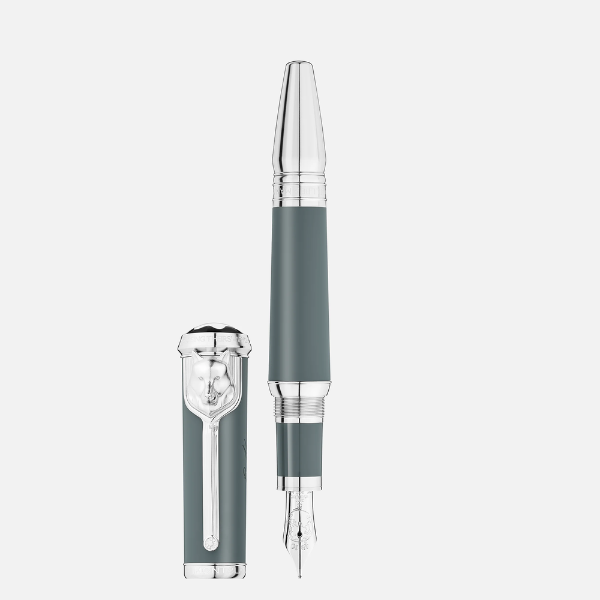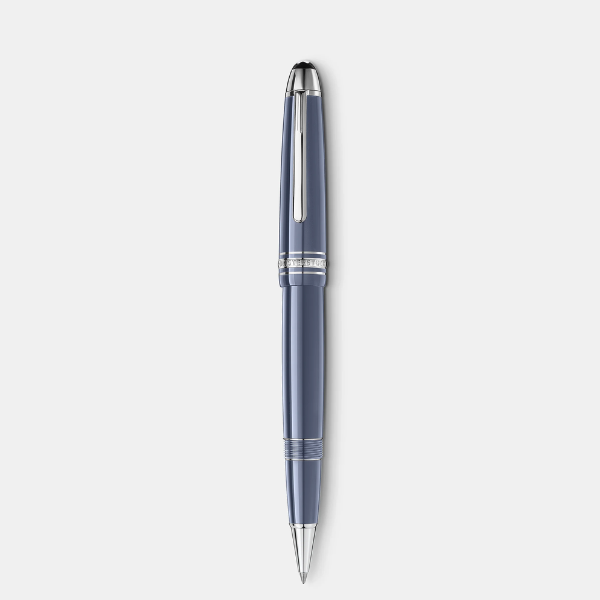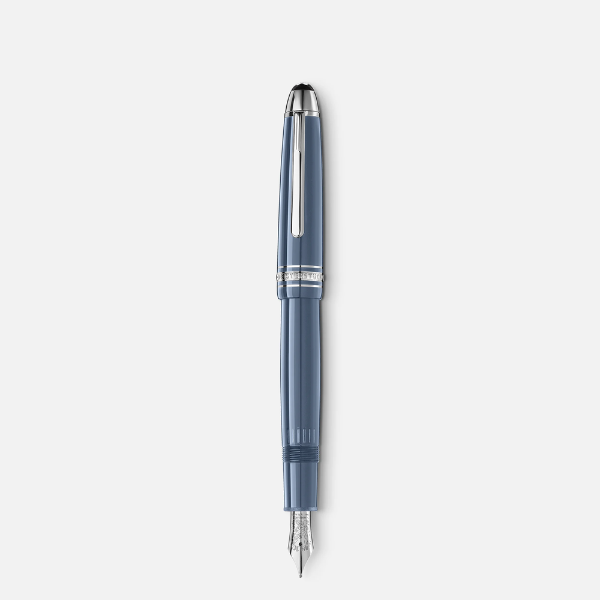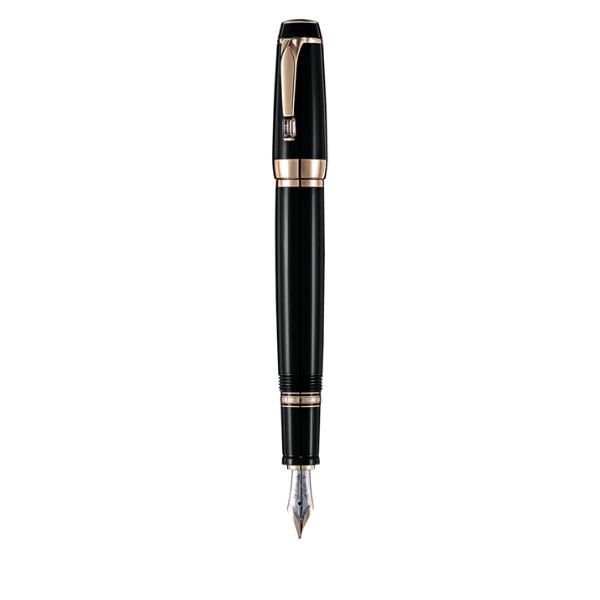Exploring the Diversity of Fountain Pens: A Comprehensive Guide to Different Types
Fountain pens, with their rich history and enduring popularity, have captivated writing enthusiasts and professionals alike for centuries. These elegant instruments are celebrated not only for their practicality in writing but also for their status as symbols of sophistication and style. This guide embarks on an exploration into the diverse world of fountain pens, aiming to uncover the myriad types and unique characteristics that make each pen distinct. From the artisan-crafted to the everyday workhorse, fountain pens offer a range of experiences defined by their design, material, and mechanics. As we delve into the details of what makes each type of fountain pen special, we will discover the artistry and engineering that contribute to the ongoing fascination with these timeless writing tools.

The Basics of Fountain Pen Design
The allure of fountain pens lies not only in their aesthetic appeal but also in the intricacy of their design. At the core of every fountain pen are fundamental components that define its functionality: the nib, feed, filling system, and barrel. Each element plays a pivotal role in the pen’s performance and contributes to the diversity found within the world of fountain pens.
- Nib: The heart of the fountain pen, the nib is the metal tip that comes into contact with the paper. It’s where the ink flows from the reservoir and onto the writing surface. The material, size, and shape of the nib can vastly influence the writing experience, offering variations in flexibility, line width, and ink flow.
- Feed: Sitting just beneath the nib, the feed regulates the flow of ink. It ensures that ink is delivered steadily to the nib, preventing leaks and ensuring a consistent line as you write. The design of the feed is crucial for maintaining a balance between ink supply and air return.
- Filling System: This mechanism is responsible for drawing ink into the pen’s reservoir. From cartridges and converters to piston and vacuum fillers, the filling system determines how ink is replenished, affecting ink capacity and the convenience of refilling.
- Barrel: The body of the pen not only houses the ink reservoir but also provides the structural integrity and aesthetic form of the pen. Materials range from plastics and metals to precious woods and resins, each offering different weights, textures, and visual designs.
Understanding these components is the first step in appreciating the diversity of fountain pens. Variations in these fundamental aspects contribute to the wide array of pens available, each designed to meet specific writing preferences and styles.
Types of Fountain Pen Nibs
The nib is arguably the most critical component of a fountain pen, directly influencing the writing experience. Its material, size, and shape are key factors that contribute to the pen’s character and functionality.
1. Nib Materials
- Gold Nibs are prized for their softness and flexibility, offering a smooth writing experience with a variable line width that responds to writing pressure. Their ability to adapt to an individual’s writing style makes them a favorite among enthusiasts.
- Steel Nibs provide durability and resistance, making them less prone to bending. While offering a firmer writing experience, they are more affordable and widely available, making them suitable for everyday use.
- Titanium Nibs strike a balance between the flexibility of gold and the strength of steel. They are lightweight and resistant to corrosion, offering a unique writing experience that combines softness with resilience.
2. Nib Sizes and Shapes
- Nib Sizes range from extra-fine (EF), fine (F), medium (M), to broad (B), directly affecting the line width and ink flow. Extra-fine nibs are ideal for detailed work, while broad nibs are preferred for bold writing and shading.
- Nib Shapes like italic, stub, and oblique nibs cater to specific writing styles and preferences. Italic and stub nibs are excellent for calligraphy and cursive writing, offering distinct line variation. Oblique nibs are angled to accommodate the natural slant of some writers’ handwriting.
The diversity in nib materials, sizes, and shapes allows for a personalized writing experience, catering to a wide range of preferences and styles. Whether seeking the flexibility of a gold nib for expressive writing or the precision of an extra-fine steel nib for detailed work, the choice of nib is integral to finding the perfect fountain pen.
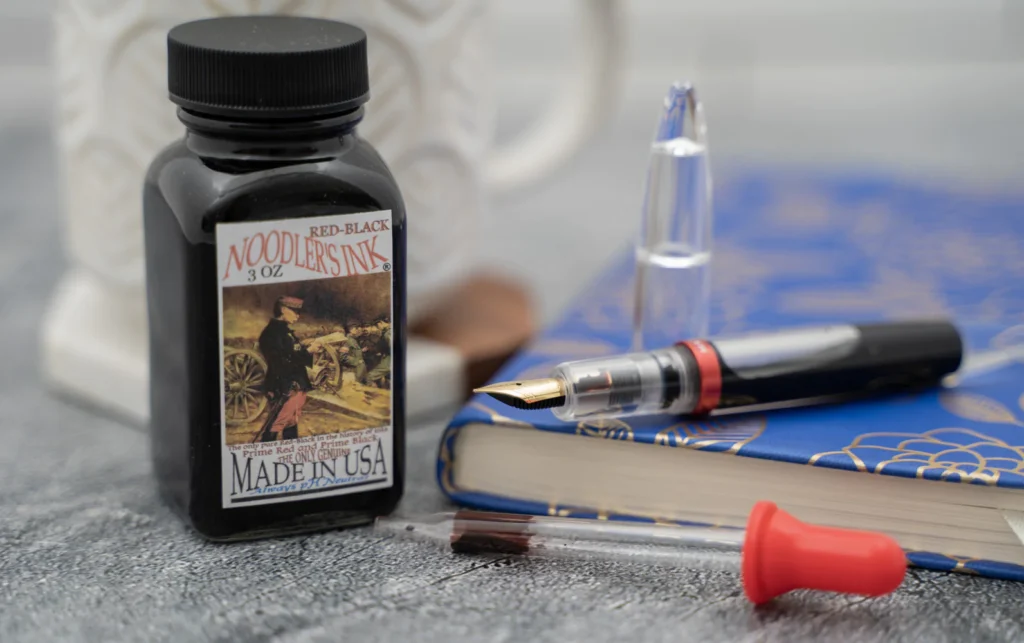
Filling Systems Explained
The filling system of a fountain pen is crucial for its operation, determining how ink is stored and supplied to the nib. This aspect of pen design not only influences the convenience and capacity of ink storage but also the overall writing experience. Here, we explore the primary types of filling systems found in fountain pens.
1. Cartridge/Converter Systems
- Cartridge systems utilize pre-filled ink cartridges for a straightforward and mess-free way to refill the pen. Ideal for those who prioritize convenience, cartridges are easily replaced but can limit ink variety.
- Converters allow pens to use bottled ink, offering greater flexibility in ink choice compared to cartridges. They operate through a piston or squeeze mechanism to draw ink into an empty cartridge, combining the versatility of bottled ink with the convenience of a cartridge pen.
2. Piston Fillers
- Piston fillers integrate the filling mechanism within the pen’s barrel, using a twist-action piston to draw ink directly into the reservoir. This system provides a larger ink capacity than cartridge/converter pens and allows for the use of any bottled ink, making it popular among enthusiasts who value both capacity and variety.
3. Vacuum Fillers
- Vacuum filling systems use a plunger to create a vacuum that draws ink into the pen’s reservoir when released. This innovative system offers a high ink capacity and a novel filling experience but can be more complex to operate and clean.
Each filling system has its advantages, from the simplicity and convenience of cartridges to the high capacity and ink variety afforded by piston and vacuum fillers. The choice of filling system affects not only how a pen is refilled but also its portability, the range of inks that can be used, and the overall user experience.
Pen Body Materials and Designs
The materials and design of a fountain pen‘s body contribute significantly to its aesthetic appeal, weight, and writing comfort. From classic to contemporary, the choice of materials can transform the look and feel of a pen, making it a personal statement piece as much as a writing instrument.
1. Precious Metals
- Gold, Silver, and Platinum: Used in high-end fountain pen designs, these precious metals are not only valued for their aesthetic appeal but also for their durability and heft. Pens crafted from these materials often feature intricate engravings and embellishments, reflecting luxury and status.
2. Resin and Acrylics
- Resin and Acrylic Pen Bodies: Offer a spectrum of colors and patterns, from transparent demonstrators that reveal the inner workings of the pen to vibrant marbled or speckled finishes. These materials are lightweight and comfortable to hold, making them popular for both everyday use and special editions.
3. Other Materials
- Wood, Celluloid, and Ebonite: These materials are prized for their unique textures and warm, natural feel. Wood pens can offer a connection to nature with each piece featuring its own distinct grain pattern. Celluloid, once common in early fountain pens, is celebrated for its depth of color and luster. Ebonite, a type of hard rubber, is valued for its durability and the comfortable grip it provides.
The choice of material impacts not only the pen’s appearance but also its balance and how it feels in the hand during writing sessions. Whether opting for the opulence of precious metals, the vibrant versatility of resin, or the natural elegance of wood and ebonite, the materials and design of a fountain pen play a key role in its functionality and allure.
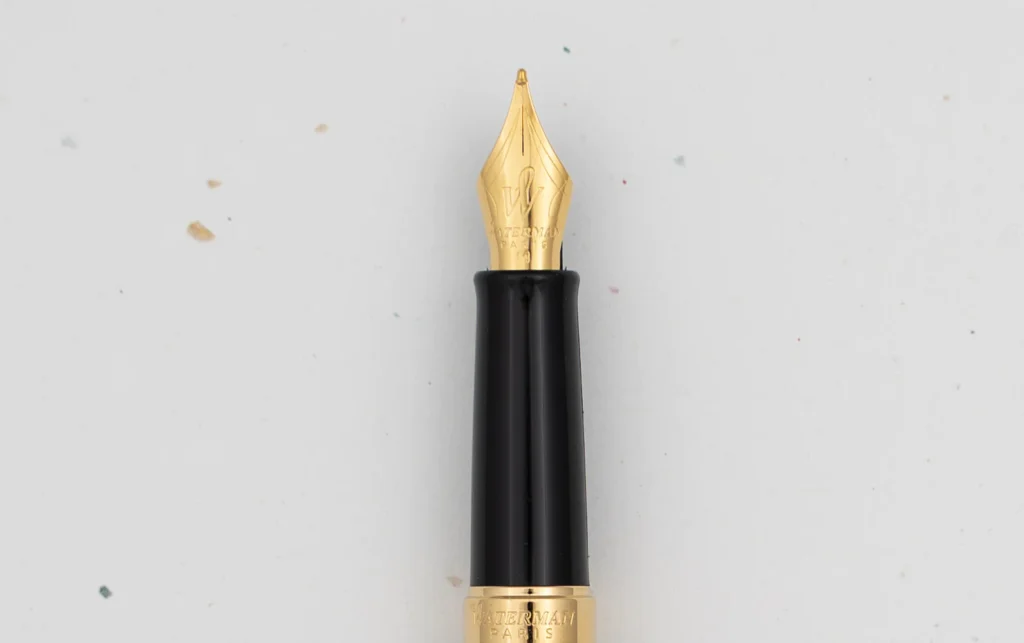
Special and Limited Edition Fountain Pens
Special and limited edition fountain pens hold a unique place in the hearts of collectors and writing enthusiasts. These pens, often released to commemorate significant events, milestones, or collaborations, are celebrated for their distinctive designs, craftsmanship, and the stories they tell.
- Commemorative Releases: Many pen manufacturers launch special editions to mark historical events, anniversaries, or achievements. These pens often feature unique motifs, engravings, and materials that reflect the occasion being celebrated, making them highly collectible.
- Artistic Collaborations: Limited edition pens may result from collaborations with artists, designers, or cultural institutions. These partnerships bring a fusion of artistry and pen-making expertise, resulting in exquisite pieces that showcase exceptional design and creativity.
- Innovative Materials and Techniques: Special and limited editions often utilize materials not typically found in standard fountain pen production, such as precious metals, exotic woods, or handcrafted resins. Advanced manufacturing techniques and hand-finishing processes contribute to the uniqueness and value of these pens.
- Collectibility and Value: Beyond their functionality as writing instruments, special and limited edition pens are sought after for their potential collectibility and investment value. The rarity and uniqueness of these pens can make them highly desirable, with some editions appreciating in value over time.
The allure of special and limited edition fountain pens lies in their ability to offer something beyond the ordinary—a blend of art, history, and craftsmanship. For enthusiasts, acquiring such a pen is an opportunity to own a piece of writing elegance that carries a story, celebrates creativity, or marks a moment in time.
Choosing the Right Fountain Pen
Selecting the right fountain pen is a personal journey that intertwines with one’s writing habits, aesthetic preferences, and budget considerations. Here’s how to navigate the myriad options to find a pen that resonates with your style and needs:
- Consider Writing Habits: Reflect on how you plan to use the pen. Daily note-takers might prioritize durability and convenience, opting for pens with robust nibs and easy-to-use filling systems. Those seeking a pen for calligraphy or artistic purposes may focus on nib flexibility and ink flow.
- Aesthetic Preferences: The look and feel of a fountain pen contribute significantly to the writing experience. From sleek, modern designs to ornate, vintage styles, the physical appeal of a pen can inspire and motivate writing. Material choices, such as resin, metal, or precious wood, also play into the aesthetic and tactile experience.
- Budget: Fountain pens are available across a wide price range, from affordable entry-level models to luxurious, artisan-crafted pieces. Determining a budget beforehand can help narrow down options and focus on pens within a feasible price range while still meeting your writing and aesthetic needs.
- Nib Selection: The nib is the heart of the fountain pen experience. Choosing the right nib material, size, and shape is crucial for achieving the desired writing feel and line quality. Don’t hesitate to experiment with different nib types to discover what suits you best.
- Test Before You Buy: Whenever possible, test a fountain pen before purchasing. How a pen feels in hand and interacts with paper is highly individual. Trying out a pen can provide insight into its balance, weight, and writing dynamics, ensuring a match that feels intuitively right.
- Research and Reviews: Leverage the wealth of information available in fountain pen communities, forums, and review sites. Learning from the experiences of others can provide valuable insights into a pen’s performance and reliability, aiding in making an informed decision.
Finding the perfect fountain pen is about more than just choosing a writing tool; it’s about discovering an instrument that complements your writing style, feels comfortable in your hand, and satisfies your aesthetic sensibilities. With thoughtful consideration and exploration, the quest for the right fountain pen becomes a rewarding journey in its own right.
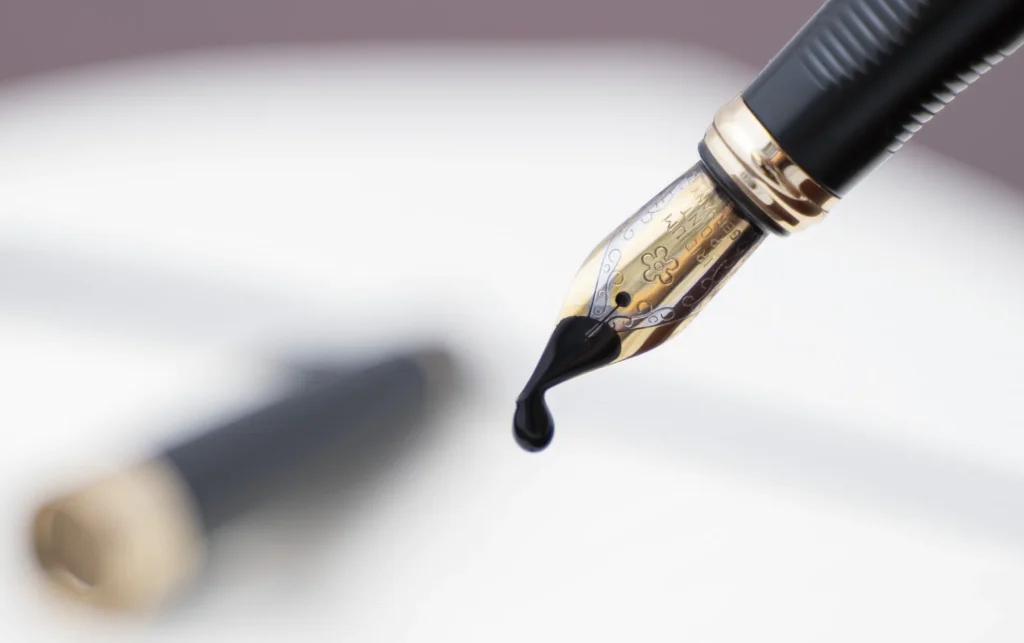
Care and Maintenance of Fountain Pens
Proper care and maintenance are essential for ensuring the longevity and optimal performance of your fountain pen. Regular upkeep not only preserves the pen’s aesthetic appeal but also maintains its writing quality. Here are key tips for the care and maintenance of fountain pens:
- Regular Cleaning: To prevent clogging and maintain smooth ink flow, it’s important to clean your fountain pen regularly. This involves flushing the nib and feed with water to remove any ink residue. For pens with converters or piston fillers, drawing water in and out of the reservoir until it runs clear can achieve thorough cleaning.
- Proper Ink Selection: Using high-quality ink specifically designed for fountain pens can prevent issues such as sediment buildup or corrosive reactions. Avoid using inks not intended for fountain pen use, as they can damage the pen’s internal mechanisms.
- Nib Care: Handle the nib gently to avoid bending or damage. When not in use, capping the pen helps protect the nib from drying out or getting damaged. If the nib becomes misaligned, consider seeking professional repair to avoid further damage.
- Storage: Store your fountain pen in a safe, dry place when not in use. If storing the pen for an extended period, it’s best to empty and clean it thoroughly to prevent ink from drying and clogging the feed.
- Avoid Dropping: Dropping a fountain pen can cause significant damage, particularly to the nib. Always clip or secure your pen properly to avoid falls.
- Use and Rotation: Regular use can keep your fountain pen in good working condition. Rotating between pens can also prevent prolonged periods of inactivity, which might lead to ink drying and clogging.
By following these care and maintenance tips, you can ensure that your fountain pen remains a reliable and enjoyable tool for writing for many years to come. Proper upkeep not only enhances the pen’s performance but also turns it into a cherished personal or heirloom item.
The journey through the diverse world of fountain pens reveals a realm where artistry meets functionality, offering writing instruments that cater to a wide range of styles, preferences, and needs. From the intricate design of the nibs to the sophisticated mechanisms of the filling systems and the aesthetic appeal of the pen bodies, fountain pens embody a unique blend of tradition and innovation.
This comprehensive guide has explored the different types of fountain pens, delving into their unique characteristics, the materials from which they are crafted, and the care they require to maintain their beauty and functionality. The joy of finding the perfect fountain pen lies in the exploration—testing various nibs, inks, and papers to discover what best suits your writing style and personal taste.
Whether you are a seasoned collector, a professional seeking a reliable writing tool, or a newcomer intrigued by the elegance of fountain pens, there is a fountain pen out there for everyone. The key is to embrace the journey, experiment with different options, and enjoy the unparalleled writing experience that fountain pens provide.
Recommended Montblanc Pens
-
Rated 5.00 out of 5
$1,280.00$896.00


